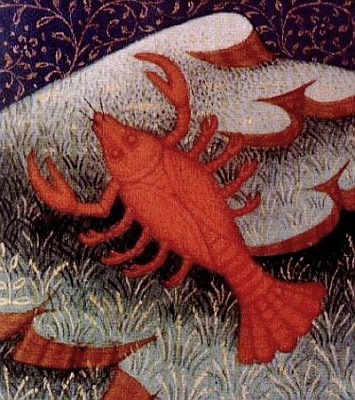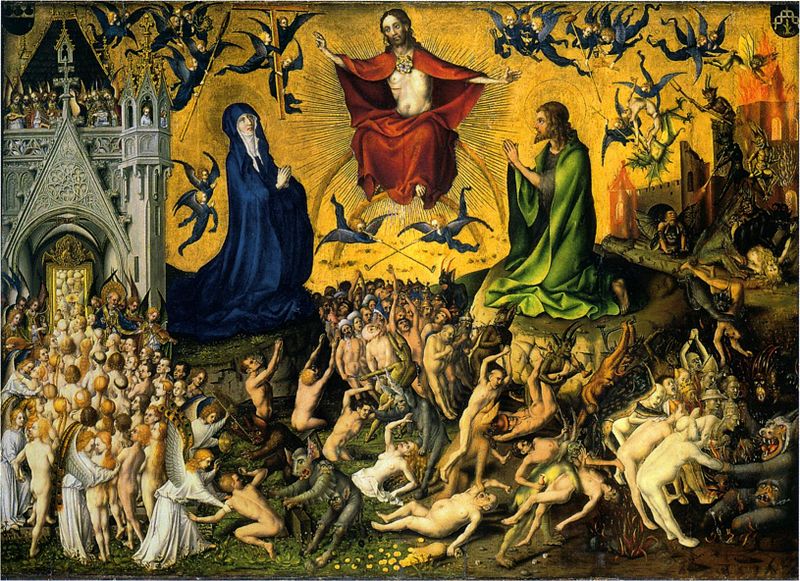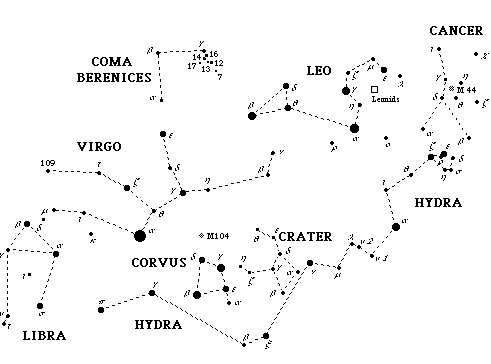|

The great Jesuit scholar, Athanasius Kircher (A.D. 1602-1680), a
metaphorial and literal "Renaissance Man," wrote that this sign was
first known, at least among those of Coptic Egypt, as Κλαρια, the Bestia seu Statio
Typhonis -- "the Power of Darkness," a fact symbolized by the
stars that make up this constellation being very dim. But
even the Greek understanding of this constellation is interesting: they
saw it as a crab -- but not just any crab. They saw it as the crab that
seized Hercules -- the third decan of Scorpius,
and symbol of Christ --
by the foot -- a foot which Hercules uses to crush it in return.
This so easily brings to mind the words of Genesis 3:15:
I will put
enmities between thee and the woman, and thy seed and her seed: she
shall crush thy head, and thou shalt lie in wait for her heel.

Just after the marriage of the Lamb in the Apocalypse,
foretold by Capricornus and fulfilled
with Gemini, we're
told of the final battle between Christ and the powers of darkness.
Apocalypse 20:7-15, 21:6-8
And when the
thousand years shall be finished, Satan shall be loosed out of his
prison, and shall go forth, and seduce the nations, which are over the
four quarters of the earth, Gog, and Magog, and shall gather them
together to battle, the number of whom is as the sand of the sea. And
they came upon the breadth of the earth, and encompassed the camp of
the saints, and the beloved city.
And there came down fire from God out of heaven, and devoured them; and
the devil, who seduced them, was cast into the pool of fire and
brimstone, where both the beast And the false prophet shall be
tormented day and night for ever and ever.
And I saw a great white throne, and one sitting upon it, from whose
face the earth and heaven fled away, and there was no place found for
them. And I saw the dead, great and small, standing in the presence of
the throne, and the books were opened; and another book was opened,
which is the book of life; and the dead were judged by those things
which were written in the books, according to their works. And the sea
gave up the dead that were in it, and death and hell gave up their dead
that were in them; and they were judged every one according to their
works. And hell and death were cast into the pool of fire. This is the
second death. And whosoever was not found written in the book of life,
was cast into the pool of fire...
...And He said to me: It is done. I am Alpha and Omega; the beginning
and the end. To him that thirsteth, I will give of the fountain of the
water of life, freely. He that shall overcome shall possess these
things, and I will be his God; and he shall be my son. But the fearful,
and unbelieving, and the abominable, and murderers, and whoremongers,
and sorcerers, and idolaters, and all liars, they shall have their
portion in the pool burning with fire and brimstone, which is the
second death.
With the Sign of Cancer, we're told that at the end of time,
the powers of darkness are rendered harmless forever! Christ and His
Bride are left to reign in perfect joy!
The crab as a creature is
interesting, too, when thinking of them in relation to the powers of
darkness. The phrase "like crabs in a barrel" refers to the propensity
of crabs to prevent other crabs from escaping when they are trapped.
Put crabs in a barrel, and when one tries to escape, another will pull
it
back down inside. This shows the tenacity of demons and of humans under
their influence. The former seethe with hatred for the Light Who is
Christ and for all who follow Him; the latter will try to keep people
from the Light as a psychological defense mechanism; those who escape
the clutches of evil's claws show up those who refuse grace. They act
as reminders of the evildoers' darkness, so those who are under the
spell of the Evil One often do all they can to keep others in the dark
and
disrupt their journey on the path of holiness.
Asides: in the constellation of Cancer is an open cluster, a
grouping of thousands of stars that are believed to have been born
together and which are bound together by gravity. This cluster is
sometimes known as "the Beehive Cluster," but its older, more common
name is
Praesepe -- Latin for "Manger." It was named this by the ancient Greeks
and Romans because they saw in it a manger from which two donkeys --
the star systems Asellus Borealis and Asellus Australis -- were eating.
But we Christians have a different view of what a manger can signify,
and here is where things get poetic: the Manger can be seen first, low
on the Eastern horizon, in December, the month of the Nativity. At the
same time, on the opposite horizon, the Northern Cross (also called
Cygnus), the third decan of Aquarius, can
be seen. The two together remind us that God was born into this world
in order to die for us. It is by Him that we escape the darkness that
Cancer symbolizes.
Just North of Cancer is a small, newer constellation called "Lynx." In
it can be found APM 08279+5255 -- a quasar -- i.e., a black hole, many
millions times larger than the Sun, surrounded by spiraling gases that
emit enormous amounts of electromagnetic radiation -- in this case,
enough radiation to equal a thousand trillion Suns. This quasar is also
surrounded by a huge mass of water -- the greatest mass of water ever
seen, a mass of 100 trillion times more water than is found on Earth.
This discovery shows that water's been found in the Universe since at
least very, very early on in its existence (if not from the beginning).
Pondering this might help us better understand Genesis 1:6-8: "And God
said: Let there be a firmament made amidst the waters: and let it
divide the waters from the waters. And God made a firmament, and
divided the waters that were under the firmament, from those that were
above the firmament, and it was so. And God called the firmament,
Heaven; and the evening and morning were the second day."
Decan One: Ursa Minor
The first and second decans of Cancer represent a Little Bear and a
Great Bear, respectively. But it's the asterisms these constellations
contain that are relevant here. In each is a wagon -- also known as the
Little Dipper and the Big Dipper, also respectively. The former was
seen as the "Women's Wagon," and the latter as the "Men's Wagon," and
old tradition relates how those "wagons" were actually funeral biers.
The "bowl" parts of these asterisms were seen as the biers themselves,
and the stars that make up their handles were seen as mourners. The
"second death" spoken of in the Apocalypse has come. "And whosoever was
not found written in the book of life, was cast into the pool of fire."
These constellations are believed by some to be the ones
typically treated as being
referred to in Job. From the Catholic Encyclopedia:
In the Book of
Job — the most distinctively astronomical part of the Bible — mention
is made, with other stars, of Ash and Ayish, almost certainly divergent
forms of the same word. Its signification remains an enigma. The
Vulgate and Septuagint inconsistently render it "Arcturus" and
Hesperus". Abenezra (1092-1167), however, the learned Rabbi of Toledo,
gave such strong reasons for Ash, or Ayish, to mean the Great Bear,
that the opinion, though probably erroneous, is still prevalent. It was
chiefly grounded on the resemblance between ash and the Arabic na 'ash,
"a bier", applied to the four stars of the Wain, the three in front
figuring as mourners, under the title of Ben�t na 'ash, "daughters of
the bier". But Job, too, speaks of the "children of Ayish", and the
inference seems irresistible that the same star-group was similarly
referred to in both cases.
Note: the star at the tip of the Little Dipper's handle, in
Ursa Minor, is Polaris, the star that always points to true North.
Decan Two: Ursa Major
See above.
Decan Three: Argo
Argo Navis, the great ship, has, in modern times, been divided up into
four separate constellations, all named for parts that make up the
ship: Carina (the Keel), Vela (the Sails), Pyxis (Compass), and Puppis
(the Stern).
Argo,
treated by the Greeks as the ship that bore Jason in
his
search for the golden fleece, can be seen as the Ark of the Church.
While the first two decans of Cancer represent the female and male
damned respectively, this decan
represents
those whose names are written in the book of life, those who've escaped
"the second death."
M. W. Ovenden, in an article called, "The Origin of Constellations,"
found in the July 1966 issue of The Philosophical Journal, writes that
this constellation was
often shown in
early representations as though atop a mountain. Coming from the ship
is the Centaur, a man-animal, sacrificing a Beast upon the Altar. We
see, too, the Water-snake (Hydra) with a Raven (Corvus) eating its
flesh. There can be no doubt that here we have, in
imagination pictured in the sky, a version of the story of Noah and the
Flood. The picture is complete with the Milky Way seeming to rise as
smoke from the Altar.
And all Catholics know that the ark of Noe
(Noah) is a type of the Church, the means
of salvation.
We'll read about Hydra and Corvus as the first and third decans of Leo,
our next Zodiacal sign.
To sum up, what we have with Cancer and its decans is the Last
Judgment, with the condemned on their funeral biers, and the saved safe
in the Ark of the Church.

Cancer can be
seen from December through June.


Cancer relative
to other stars in the Spring sky:

|
|

![]()
